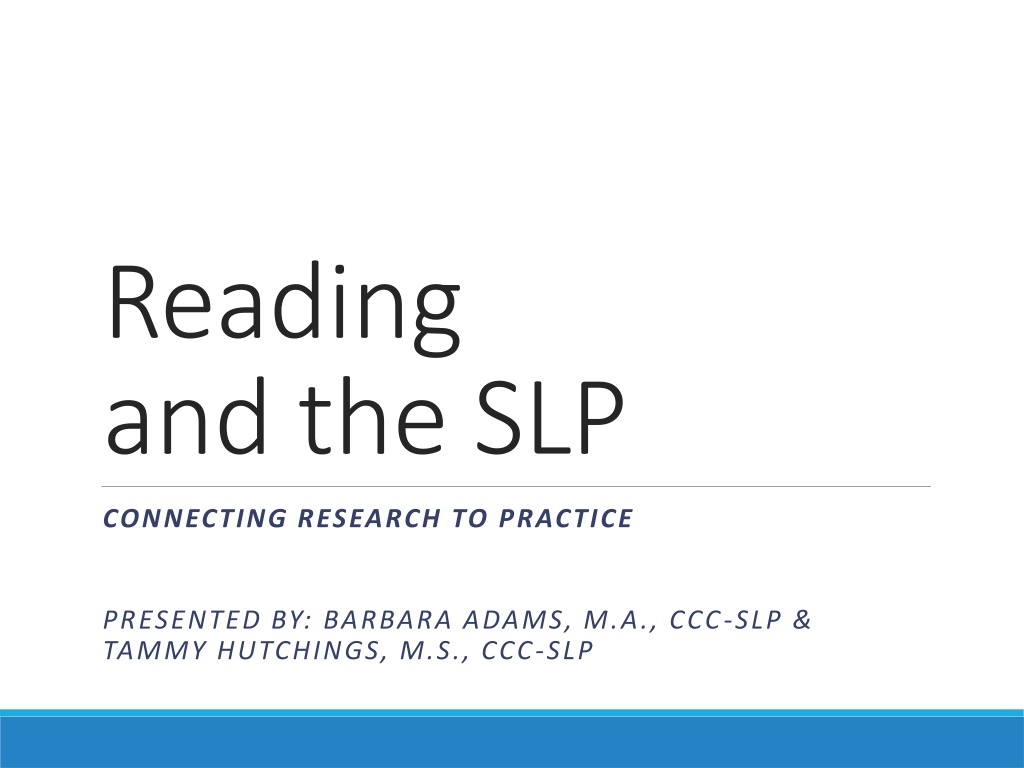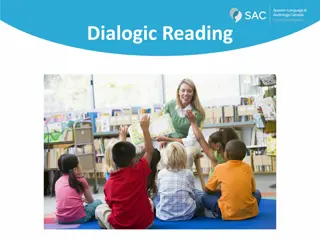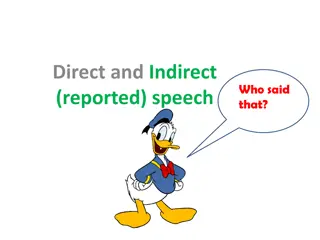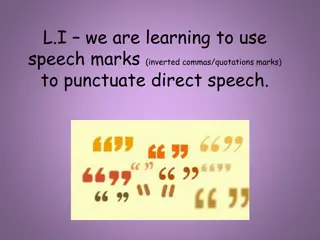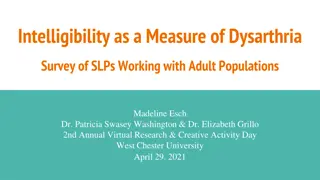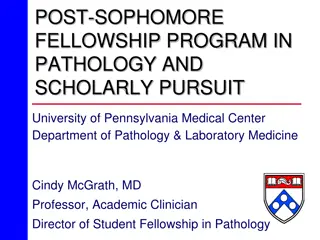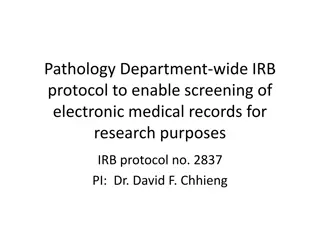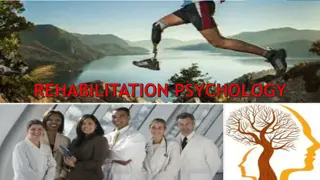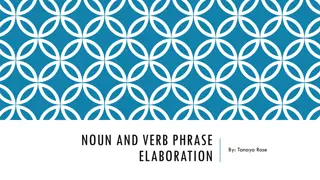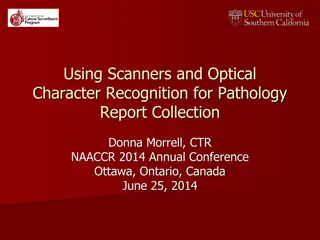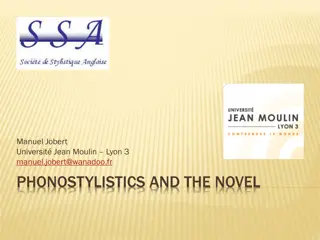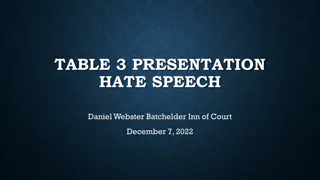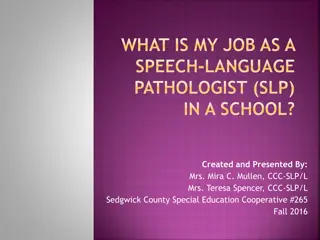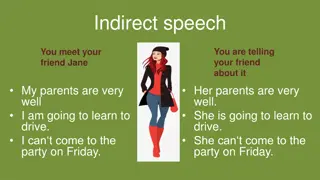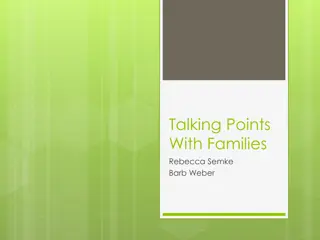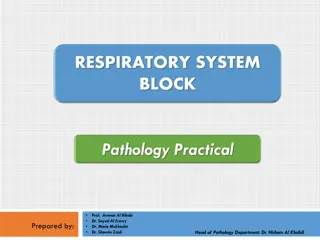Insights into Reading: Connecting Research to Practice in Speech-Language Pathology
Delve into the vital connection between research and practice in speech-language pathology regarding reading skills. Topics covered include statistics, current models of reading, language and reading connections, assessment definitions, how SLPs assist with reading, and the significance of team collaboration in treating reading-based disorders. Uncover the prevalence of reading difficulties, the importance of key reading areas, and different reader categories to enhance understanding.
Download Presentation

Please find below an Image/Link to download the presentation.
The content on the website is provided AS IS for your information and personal use only. It may not be sold, licensed, or shared on other websites without obtaining consent from the author. Download presentation by click this link. If you encounter any issues during the download, it is possible that the publisher has removed the file from their server.
E N D
Presentation Transcript
Reading and the SLP CONNECTING RESEARCH TO PRACTICE PRESENTED BY: BARBARA ADAMS, M.A., CCC-SLP & TAMMY HUTCHINGS, M.S., CCC-SLP
Overview 1) Statistics 2) Simple View to Current Models of Reading 3) Development of Reading 4) Language and Reading Connections 5) Reading Comprehension Skills 6) Definitions of Deficits and Assessment 7) How Can SLPs Help with Reading? 8) Concluding Thoughts
TRUE or FALSE Colored overlays help a child with dyslexia read better False! Those with dyslexia see words backwards False! A child who reverses letters definitely has dyslexia False! SLPs are the only professionals qualified to assess students with dyslexia False! Team collaboration is important when assessing and treating language and/or reading based disorders. True!
Nearly 50% of children enter Kindergarten with at least one risk factor that may negatively affect academics National Assessment of Education Progress (2015) estimates that 37% of 12th graders scored at or above proficient level in reading What about the remaining 63%? For 4th graders in Tennessee, 66% are reading at or above the basic level The STATS There are 34% of students who are not reading at basic level The estimated prevalence of language impairment in U.S. children ages 3-17 is 3.3% (National Institute of Health) International Dyslexia Association (IDA), 15-20% of people have some symptoms of dyslexia. Dyslexia affects approximately 3-10% of school-age children (Duff and Clarke, 2011). IDA: Of all students in special education that are classified as Learning Disabled, approximately 85% of these students have a primary learning disability in reading
What areas are the most important for skilled reading? 5 Areas of Reading (National Reading Panel, 2000): Phonological Awareness Phonics Fluency Vocabulary Comprehension
The Simple View of Reading Gough and Tunmer (1986)
Different Categories of Readers
Is it still that simple? There are more components to reading than just word recognition and listening comprehension: Background knowledge Vocabulary Inferencing Metacognition Since Gough and Tunmer's (1986) work, many others have contributed to our understanding of the complexities of reading: o Matthews effect (Stanovich, 1986 ) o 4 phases of sight word learning (Ehri, 2005) o Lexical Quality Hypothesis (Perfetti, 2007)
Matthew Effects Poor reader reads less than peers Poor reader (Stanovich, 1986) " To all those who have, more will be given, and they will haveanabundance; but from those who have nothing, even what they willhavewill be taken away."Matthew 25:29 Over time, lack of reading has negative effects on language development Less reading = reduced background knowledge Less reading = less exposure to vocabulary
Reading & Vocabulary Growth (Anderson, R., Wilson, P., & Fielding, 1988) Reading Scores (Percentile Ranks) Time Spent Reading Each Day Approximate Words Read Per Year 10th < 1 min 8,000 50th 4.6 min 282,000 90th 20 min 1.8 million
Four phases: Sight Word Learning Pre-Alphabetic Partial Alphabetic (Ehri, 2005) Alphabetic Letter-sound connections are learned Consolidated
Lexical Quality Hypothesis: * Orthography * Phonology * Grammar * Meaning * Constituent binding (Perfetti, 2007) The quality with which one represents words within his/her own lexicon has implications for reading comprehension abilities * Stability * Synchronicity * Meaningintegration
Stages of reading development CHALL, 1983; "LITERACY DEVELOPMENT CONTINUUM"
Awareness & Exploration Birth pre-school PRE-READING Building foundations Touch books, hear books
Early Emergent Literacy 4-5 years or preschool Engagement Books = stories In this period, children are learning about print and sound
Emergent Literacy Children learn to read Text = meaning Emphasis on phonological awareness/phoneme awareness Sight word knowledge One of the best predictors of reading success in Kindergarten and 1st grade is phoneme segmentation (Richards, 1999)
Developing/Early Independent/ Transistional Grades 1 & 2 Reading is interesting! Words + words = sentences Open ended questioning
Conventional/Fluent/ Independent Reading to learn; mid-elementary Continue to focus on accuracy and fluency Comprehension! Metacognition! Decoding multi-syllabic words Prefixes and Suffixes Im, un, ly, able
Expanding Acquiring knowledge Analytical/critical thinking Differing points of view Various reasons for reading/writing
Language and Reading Reading involves language skills Reading requires phonological, semantic, syntax, and pragmatic aspects of language (Khami and Catts, 2012) Deficits in any of these areas affect reading Children identified with language impairment in younger grades may have later reading problems (Khami and Catts, 2012) oLanguage problems may also be a result of limited reading exposure oMatthew Effects (Stanovich, 1986) Discourse Syntax Semantics Phonology
Reading Comprehension Reading comprehension is made up of many skills: Background knowledge Decoding Vocabulary Understanding of sentence structure Working memory Inferences Metacognition
Why is reading SO difficult? o There is no reading center in the brain like there is for language o Reading is not an innate ability; it is a learned skill o Children must be taught explicitly how to connect letters and sounds o To read, the brain uses existing structures that work together oOccipital lobe Parietal lobe Temporal lobe
In addition... As maturation occurs, not all skills bear the same weight. oThe influence of word recognition and listening comprehension on reading comprehension changes over time. oListening comprehension predicts later reading comprehension skills Implications: Children with typical word reading but language problems may develop later reading comprehension problems in upper grade. Sometimes referred to "late emerging reading disorders" For example: o 1st grade: Word recognition more influential than listening comprehension o 2nd grade and up: Listening comprehension has more influence on reading comprehension Castles, Rastle, and Nation (2018)
What is Dyslexia? Dyslexia is a specific learning disability that is neurobiological in origin. It is characterized by difficulties with accurate and/or fluent word recognition and by poor spelling and decoding abilities. These difficulties typically result from a deficit in the phonological component of language that is often unexpected in relation to other cognitive abilities and the provision of effective classroom instruction. Secondary consequences may include problems in reading comprehension and reduced reading experience that can impede growth of vocabulary and background knowledge. Adopted by the International Dyslexia Association (IDA) Board of Directors, Nov. 12, 2002.
Early Signs ofDyslexia Preschool-Early Elementary Oral language delay Difficulty sounding out simple one-syllable words Speech sound errors Cannot rhyme Difficulty learning letters and sounds Mixing up sounds in words cakecup or "aminal" Relative with dyslexia
Later Signs of Dyslexia o Persistent poorly developed phonological awareness skills o Trouble recalling sight words o Poor spelling o Poor decoding o Slow rate of reading o Mixing up sounds and syllables o Writing can be affected o Dysgraphia o May have difficulty learning a second language
What is Language Impairment? * TN DOE and ASHA Closely aligned definitions - Impairment in comprehension and/or use of spoken language - May include written and/or other communication symbols - May involve form, content, and/or use * phonology, morphology, syntax * semantics * pragmatics Difference in definitions: TN DOE includes, "adversely affecting the child's educational performance"
Language Impairment o If an identified language impairment is a primary disability it is labeled specific language impairment (SLD) onot accompanied by intellectual disability, global developmental delay, hearing or other sensory impairment, motor dysfunction, or other mental disorder or medical condition
What is Specific Learning Disability (SLD)? "The term Specific Learning Disability means a disorder in one or more of the basic psychological processes involved in understanding or in using language, spoken or written, which may manifest itself in the imperfect ability to listen, think, speak, read, write, spell, or do mathematical calculations and that adversely affects a child s educational performance" (www.tn.gov)
Eligibility Categories involving Reading Difficulties Specific Learning Disability (SLD) in Basic Reading or Reading Fluency Difficulties with word recognition Typically well-developed higher-order language skills Specific Learning Disability (SLD) in Reading Comprehension Typically good word recognition skills Struggle specifically with comprehension of text Mixed type Difficulty with both word recognition and comprehension Language Impairment (LI) * Dyslexia can co-occur with Language Impairment
TNDOE: Language Assessment Guidelines * minimum of one comprehensive standardized measure * falls at least 1.5 standard deviations below the mean * based on whole test or composite scores (not individual subtests) TN.Gov: Standards for Special Education and Eligibility
Assessment of Reading A comprehensive assessment of reading skills should include the following: o Phonological Processing oAwareness of the sound structure of language oWord Reading oSingle words oPseudoword Decoding oBlip, Sote, Rigfap oOral Reading Fluency
Assessment of Reading Reading Comprehension Two or more measures are ideal! Reading Comprehension tests are measuring it differently Spelling Listening Comprehension Receptive Vocabulary Understanding spoken discourse Writing sample
Group Activity Read the following scenario and think about these questions: oBased on the Simple View of Reading, what category would you classify this student? oWhy do you think that? oWhat could be done to help?
Scenario Bridget recently began the 3rd grade and her teacher has concerns about her reading and spelling. Bridget has always lagged behind classmates in early literacy skills such as letter naming, rhyming, and decoding simple words. Although she was behind, her teacher in the earlier grades did not seem concerned. When Bridget s mom expressed concern about her progress in reading, the teachers told her that she ll catch on and to give her more time. Since beginning third grade, Bridget has trouble decoding more complex words, remembering sight words, and her reading is slow, labored, and monotone. Bridget receives speech therapy to address misarticulation of /r/. Her language scores are above average. Despite reading difficulties, Bridget s mother describes her as very articulate with a large vocabulary . Bridget enjoys being read to but is beginning to avoid the books and readings that are assigned by her teacher.
How can SLPs help with reading? o We can help them break the reading code o Reading is a puzzle o Children need to understand that spoken words can be broken up into tiny bits of language o These tiny bits of language are phonemes o Understanding of phonemes is phonemic awareness o Once phonemic awareness is understood, the child is ready to link speech sounds to actual letters o For example, the child learns that cat is actually made-up of three sounds or phonemes
How can SLPs help with reading? oSLPs provide interventions at all levels of language oPhonology oSemantics oSyntax oPragmatics oDiscourse processing oBuilding early language facilitates later reading comprehension (Cain and Oakhill, 2007) oSLPs help students with reading skills at all levels of language
What is the role of the SLP for reading in the schools? o Provide assessment and treatment for language impairments that can affect reading development o Integrate phonological awareness skills in therapy sessions o Assist parents in fostering speech, language, and literacy skills at home o Help teachers identify future struggling readers
What does the research say? Systematic phonics instruction teaches children the relationship between letters and sounds. This type of instruction is especially critical for poor readers These programs have a specific scope and sequence for instruction Decodable books are great for beginning readers o BUT....restricted in vocabulary o More skilled readers benefit from wide reading o Read beyond just decodable books o Most vocabulary is learned from books rather than conversations o Vocabulary builds comprehension!
Research Continued........ Teaching morphology may help with literacy development (Castles, Rastle and Nation, 2018) Oral language skills in preschoolers is associated with later reading comprehension (Cain and Oakhill, 2007). Vocabulary instruction can help with reading comprehension skills Synonyms Context clues Discussing words in detail; not just definitions Children benefit from knowing about cohesive devices oPronouns oConnectives
The BIG Take-Away Language is a foundational component of reading comprehension There is not a one- size-fits-all approach to reading comprehension assessment and/or intervention Professional collaboration can greatly impact outcomes SLPs can target language skills to improve reading comprehension Practices should be evidence-based Student motivation can be a key to time spent reading
Resources American Speech-Language and Hearing Association (ASHA) www.asha.org Florida Center for Reading Research (FCRR) http://www.fcrr.org IES Practice Guides Foundational Skills to Support Reading K-3 Improving Reading Comprehension in Kindergarten through 3rd grade http://ies.ed.gov/ncee/wwc/PracticeGuides International Dyslexia Association http://dyslexiaida.org
More Resources....... Phonological awareness intervention: Beyond the Basics o Schuele and Boudreau (2008) article for best practices for speech- language pathologists Reading Rockets http://www.readingrockets.org What Works Clearing House (WWC) http://ies.ed.gov/ncee/wwc
References Anderson, R., Wilson, P., Fielding, I. (1988). Growth in reading and how children spend their time outside of school. Reading Research Quarterly, 23, 285-303. Cain, K. & Oakhill, J. (2007). Children's comprehension problems in oral and written language: a cognitive perspective. New York, NY: The Guilford Press. Castles, A., Rastle,K., & Nation, K. (2018). Ending the reading wars: reading acquisition from novice to expert. Psychological Science in the Public Interest, 19, 5-51. Chall, J. S. (1983). Stages of reading development. New York, NY: McGraw Hill. Duff, F. & Clarke, P. (2011). Practitioner Review: Reading disorders: what are the effective interventions and how should be implemented and evaluated? The Journal of Child Psychology and Psychiatry, 52, 3-12. Ehri, L.C. (2005). Learning to read words: Theory, findings, and issues. Scientific Studies of Reading, 9, 167-188.
References Gough, P.B., & Tunmer, W.E. (1986). Decoding, reading, and reading disability. Remedial and Special Education7(1), 6-10. Khami, A., & Catts, H. (2012). Language and Reading Disabilities, Third Edition. Upper Saddle River, NJ: Pearson Education, Inc. International Dyslexia Association. (n.d.). Retrieved from: https://dyslexiaida.org Literacy Development Continuum. (n.d.). Retrieved from: http://literacy.nationaldb.org/ National Reading Panel (2000). Teaching students to read: An evidenced-based assessment of the scientific research literature on reading and its implications for reading instruction. Retrieved from: http://www.nichd.nih.gov/research/supported/nrp
References National assessment of educational progress (2015). Retrieved from: https://www.gadoe.org/Curriculum-Instruction-and- Assessment/Assessment/Pages/NAEP.aspx National center for education statistics (2017). National assessment of educational progress. Retrieved from: https://nces.ed.gov/nationsreportcard/ National institute of deafness and other communication disorders (n.d.). Quick statistics about voice, speech, language. Retrieved from: https://www.nidcd.nih.gov/health/statistics/quick-statistics-voice-speech-language Perfetti, C. (2007). Reading ability: Lexical quality to comprehension. Scientific Studies of Reading, 11, 357-383. Richards, R. (1999). The Source for Dyslexia and Dysgraphia. East Moline,Illinois: LinguiSystems, Inc.
References Schuele, C.M., & Boudreau, D. (2008). Phonological awareness intervention: Beyond the basics. Language, Speech, and Hearing Services in the Schools, 39, 3-20. Tennessee department of education. (n.d.). Special education evaluation and eligibility. Retrieved from: https://www.tn.gov/education/student- support/special-education/special-education-evaluation-eligibility.html American Speech-Language and Hearing Association. (n.d.). Spoken language disorders. Retrieved from: https://www.asha.org/Practice-Portal/Clinical- Topics/Spoken-Language-Disorders/ Stanovich, K. (1986). Matthew effects in reading: Some consequences of individual differences in the acquisition of literacy. Reading Research Quarterly, 21, 360-407.
Questions? For any questions regarding this presentation contact us at: Barbara Adams: barbara.adams@wcs.edu Tammy Hutchings: tlh8b@mtmail.mtsu.edu
